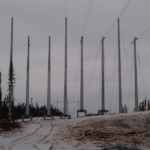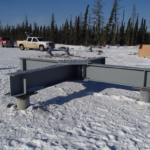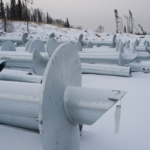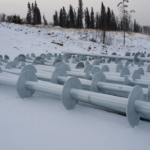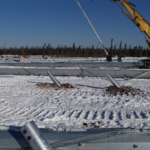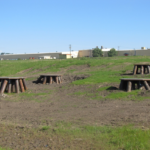Hanh N. Hong, MSc, P.Eng., PE brings over 15 years of technical expertise to Twining. Serving as Project Engineer in our Sacramento office, Hanh’s experience includes project management, materials testing and geotechnical engineering consulting services relative to the following business sectors: water/wastewater facilities, oil and gas, electrical power, residential/commercial development, schools and universities, industrial, healthcare facilities, transportation and infrastructure, and mining. He has provided project management, geotechnical and materials testing services on numerous projects from the initial planning and conceptualization phase to final design and construction.
WHAT IS A HELICAL PILE
Helical piles, also known as screw piles, helical piers, screw anchors or screw piles, are deep foundation piles that utilize one or more helical shaped circular bearing plates welded to a steel central shaft. A typical helical pile is shown below
WHY USE HELICAL PILES
The use of helical piles as an alternative to conventional deep foundations has increased in recent years. This is due to several advantages over conventional cast-in-place bored piles: cost effective; versatile (can be used in countless applications where a deep foundation is required); faster and quieter installation than driven piles; produces no soil cuttings; can be installed in most soil profiles; loads can be transmitted to the piles immediately upon completion of installation; can be installed in most weather condition (rain, sun, snow); in some cases the piles can even be reusable.
Helical piles however, cannot be installed in competent rock, or hard clays. Very dense soils and soil profiles containing gravels, cobbles and boulders pose challenges for the installation of helical piles.
HISTORY OF HELICAL PILES
Helical piles have been used since the 1800’s as pile foundations for lighthouses. Alexander Mitchell used screw piles for a light house in 1836, which appeared in the Civil Engineers and Architects Journal, Volume 12, 1848 (see below).
HOW HELICAL PILES HAVE BEEN USED
When it comes to helical piles, many assume that helical piles can only be used for small load bearing applications. This is true for small helical piles with shaft diameters of less than say 4 to 6 inches. These are widely used for small load bearing applications such as: foundation underpinning, street lamps, pre-fabricated residential camps and offices, tie downs for canopy structures, tiebacks anchors in retaining walls, etc.
However with increased technology and research in design, fabrication and installation, helical piles can be designed to carry much larger loads (ultimate capacity of 450 to 670 kips [2,000 to 3,000 kN] in compression and up to 450 kips [2,000 kN] in tension). These larger capacity helical piles (with shaft diameters of up to 36 inches) have found their use in the heavy oil and gas industry, and overhead electrical transmission projects. Other applications for these large helical piles include: foundations for anchor thrust blocks, pipe racks, well pads, lattice towers and monopole support. We have provided examples below.
DESIGN PHILOSOPHY
The design of a single helical pile depends on many factors, including: soil profile and soil geotechnical properties (undrained strength or friction, unit weight, etc.), loading conditions (compression, lateral and uplift; static vs. dynamic), pile geometry (pile shaft diameter, helix diameter, number of helices), corrosion considerations, and design life. The geotechnical capacity of a single helical pile is developed through shaft resistance and end bearing resistance of each individual helix.
Typically an engineer needs to consider the geotechnical capacity as well as structural capacity; however, the geotechnical capacity is the governing parameter. In Canada, the design of helical piles has been incorporated into the latest version of the Canadian Foundation Engineering Manual, Section 18.2.1.4.
HELICAL PILE INSTALLATION
Helical piles are installed using excavators fitted with a rotary driver head attachment. Below is an example.
The “true flight helix” of a helical pile allows it to be screwed into the ground with little ground disturbance and minimizes augering of the soil. Most often, pile designers would conduct pile load testing in compression, tension, and lateral loading in order to evaluate the piles ability to be installed for the ground condition, and to evaluate the capacity to torque ratio (K) for each pile type/geometry for a given soil condition. This is generally used to optimize pile design before mass production. Generally, geotechnical capacity of an individual helical pile is evaluated in the field using correlations of torque to capacity derived through extensive field pile load testing and experience.


